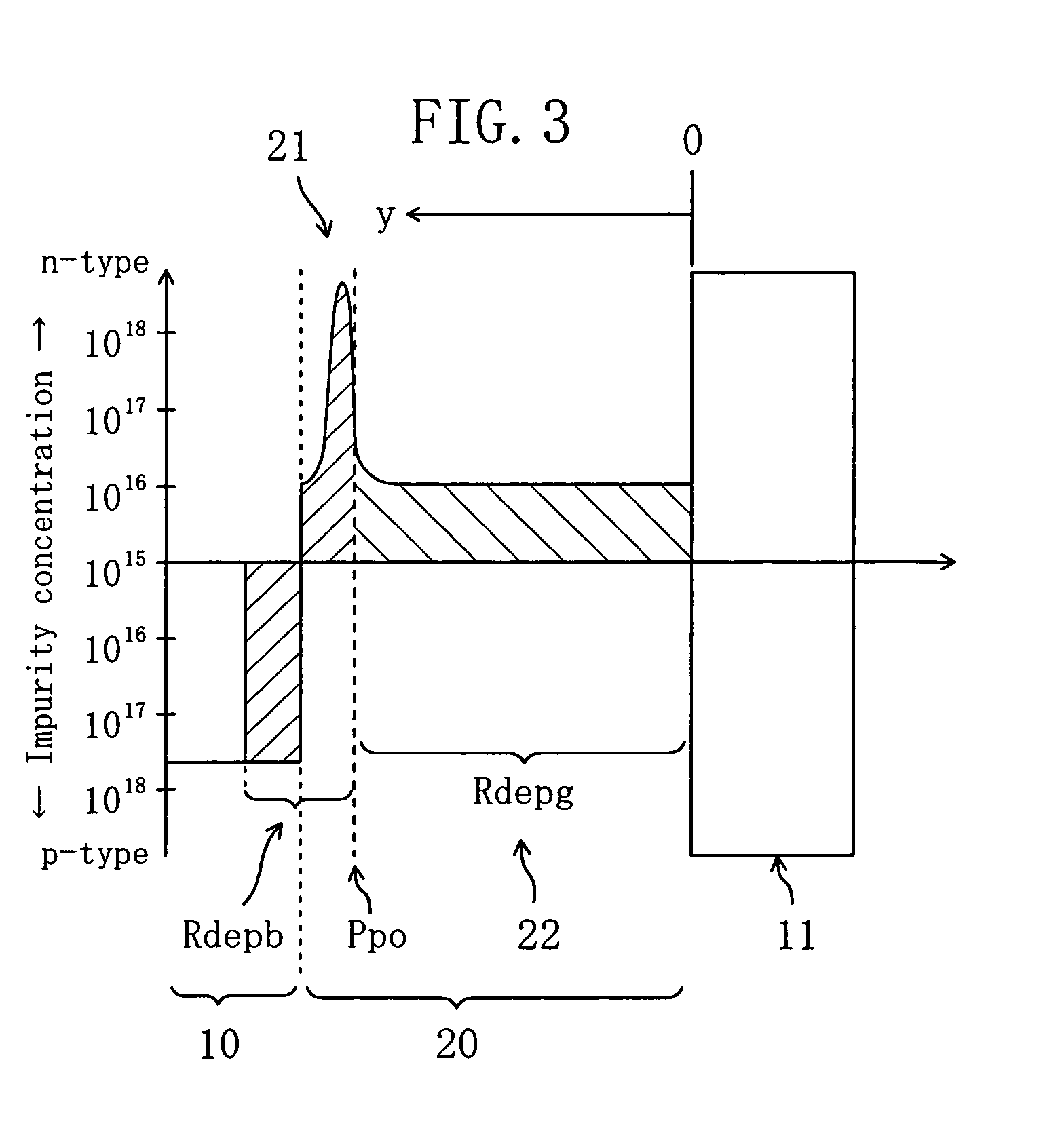Semiconductor device
a technology of semiconductor devices and semiconductors, applied in the field of semiconductor devices, can solve the problems of interface traps in a region, reduced channel conductance of insulated-gate sic devices, and many problems to be overcome, so as to achieve the effect of increasing the mobility of current flowing
- Summary
- Abstract
- Description
- Claims
- Application Information
AI Technical Summary
Benefits of technology
Problems solved by technology
Method used
Image
Examples
first embodiment
[0062
[0063]FIG. 1 is a cross sectional view illustrating the basic structure of a semiconductor device (SiC-MISFET (d-DACFET)) in accordance with a first embodiment of the present invention.
[0064]As shown in FIG. 1, the SiC-MISFET of this embodiment includes an epitaxial SiC layer 9 formed by epitaxial growth on an SiC substrate (not shown) having a 4H—SiC structure. The epitaxial SiC layer 9 includes a p-type SiC layer 10, an n-type channel layer 20, a gate insulating film 11, a gate electrode 12, an n-type source layer 13a, and an n-type drain layer 13b. The p-type SiC layer 10 is a base region. The n-type channel layer 20 is formed on the p-type SiC layer 10 and modulation-doped by in-situ doping. The gate insulating film 11 is formed on the channel layer 20 by thermal oxidation. The gate electrode 12 is formed on the gate insulating film 11. The respective n-type source and drain layers 13a and 13b are formed by implanting an n-type impurity into regions in the channel layer 20 ...
second embodiment
[0090
[0091]FIG. 7 is a cross sectional view illustrating the basic structure of a semiconductor device (SiC-MISFET (d-DACFET)) in accordance with a second embodiment of the present invention.
[0092]As shown in FIG. 7, the d-DACFET of this embodiment includes an epitaxial SiC layer 29 formed by epitaxial growth on an SiC substrate (not shown) having a 4H—SiC structure. The epitaxial SiC layer 29 includes a p-type SiC layer 30, which is a base region, and an n-type channel layer 40, which is formed on the p-type SiC layer 30 and modulation-doped by in-situ doping. The d-DACFET of this embodiment further includes a gate insulating film 31, a gate electrode 32, an n-type source layer 33a, and an n-type drain layer 33b. The gate insulating film 31 is formed on the channel layer 40 by thermal oxidation. The gate electrode 32 is formed on the gate insulating film 31. The respective n-type source and drain layers 33a and 33b are formed by implanting an n-type impurity into regions in the cha...
third embodiment
[0098
[0099]FIG. 8 shows relationship between the impurity concentrations of a channel layer and a pSiC layer, and depletion layers in a semiconductor device (SiC-MISFET (d-DACFET)) in accordance with a third embodiment of the present invention. As shown in FIG. 8, the d-DACFET of this embodiment includes in the channel layer, instead of the 6 doped layer 21 in the d-DACFET of the first embodiment shown in FIG. 1, a graded doped layer (high-concentration doped layer) in which impurity concentration decreases heading from its deeper portion toward its surface. The lower end of the graded doped layer is in contact with the pSiC layer. The impurity concentration of the deepest portion of the graded doped layer, which is about 5.0×1018·cm−3, decreases almost continuously tending toward the impurity concentration (about 1.×1016·cm−3) of the undoped layer. The graded doped layer has a thickness of about 10 nm.
[0100]In the d-DACFET of this embodiment, a depletion layer Rdepb that extends fr...
PUM
 Login to View More
Login to View More Abstract
Description
Claims
Application Information
 Login to View More
Login to View More - R&D
- Intellectual Property
- Life Sciences
- Materials
- Tech Scout
- Unparalleled Data Quality
- Higher Quality Content
- 60% Fewer Hallucinations
Browse by: Latest US Patents, China's latest patents, Technical Efficacy Thesaurus, Application Domain, Technology Topic, Popular Technical Reports.
© 2025 PatSnap. All rights reserved.Legal|Privacy policy|Modern Slavery Act Transparency Statement|Sitemap|About US| Contact US: help@patsnap.com



